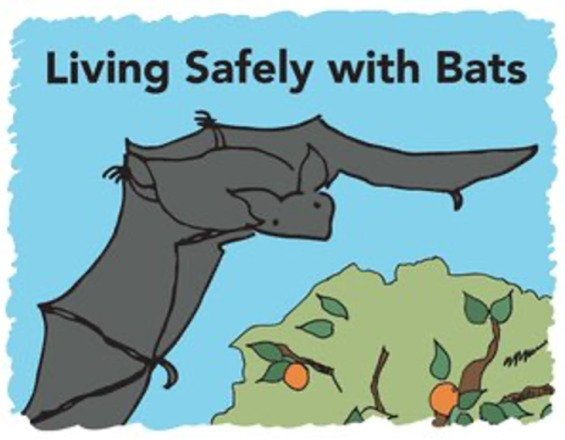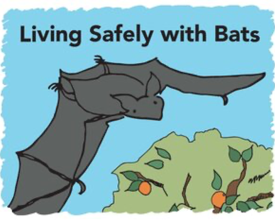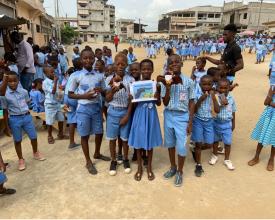
Living Safely with Bats: A One Health Educational Resource

As part of a public health communication strategy related to the identification of a novel filovirus in bats in West Africa, an initiative was launched to create a widely accessible One Health educational and risk communication resource for community outreach. A moderated picture book was developed, titled Living Safely with Bats, that now has been adapted, translated, and used in more than 20 countries in Africa and Asia. This product includes text and artwork developed by a consortium of public health, veterinary health, conservation, bat, and disease ecology experts from 29 countries. The book is a collection of evidence-based prevention measures which encourage community members to live safely with bats and avoid exposure to potential zoonotic threats.
Contexte
Challenges addressed
After the detection of Bombali ebolavirus (BOMV) in Sierra Leone and in response to identified knowledge gaps about zoonotic disease transmission risk during the 2013-16 Ebola outbreak in West Africa, an initiative was launched to create a One Health educational resource to help communities manage their exposure risk to pathogens found in bats. This resource aimed to facilitate informed discussions on ways to reduce contact and disease transmission risk and to include information of the beneficial ecosystem services that bats provide.
Emplacement
Traiter
Summary of the process
The presence of each of these building blocks was essential to ensuring their collective success – without local knowledge and the collaboration of technical experts, the risk communication demonstrated throughout this project would not have been effective or useful. A clear communication strategy between local actors and collaborators ensured all of the relevant information was captured and translated into comprehensive books for wide audiences. Each of these building blocks amplify each other, resulting in better health outcomes for people, wildlife, and their environment.
Building Blocks
Utilizing local knowledge
The content was developed to be broadly applicable and accessible to communities living near natural bat habitats. While concepts were broadly applicable, the images and text were also adapted to specific local cultural contexts so as to be locally relevant. The picture book’s content was divided into 6 key modules that addressed the topics identified as most relevant by local stakeholders and subject matter experts. A modular format was integral for the various teams to be able to adapt to differing presentation contexts (e.g. short meetings, multi-day workshops) as well as differing risk compositions (e.g. hunting communities, communities with or without bat tourism). Trusted community leaders, such as village elders or community health agents, were identified as individuals who could best fulfill the moderator role as they serve as powerful local actors in combatting rumors and disinformation.
Enabling factors
To ensure the content of the bat book was accurately representative of the local culture, input and direction was taken from local leaders and stakeholders. Established relationships between the international PREDICT team and the local actors enabled successful translations and community uptake across numerous countries around the world.
Lesson learned
While the overarching concepts communicated in the bat book are derived from global scientific studies, the communication of this information is best done through a local language and format. In addition to the translation of text, the pictures were updated to represent the local community and feedback was collected on diagrams to ensure the message was easily understood. The essential information communicated through the bat book is more readily trusted and accepted by communities when they have a stake in its creation and direction.
Collaboration across knowledge domains and sectors
While managed by a central technical and design team, the picture book, entitled Living Safely with Bats, is a product of a multi-country, multi-disciplinary collaboration. From inception to distribution, every effort was made to incorporate the cultural contexts, local knowledge, and technical expertise from within the consortium, which included social scientists, veterinarians, clinicians, ecologists and epidemiologists from all of the countries in which the book was intended for the first round of implementation.
Enabling factors
Open and clear communication channels ensured that previously siloed sectors were able to collaborate and share ideas. The PREDICT team often served as the bridge between diverse stakeholders, identifying areas of overlap and bringing together local and international actors to develop locally-relevant guidance, strategies, and solutions.
Lesson learned
Allowing local stakeholders to guide discussions on needs, context, and optimal outcomes allowed for context specific plans to be crafted in the design and dissemination. Technical experts were then able to contribute input to ensure the scientific background was up-to-date and high safety standards were adhered to. These collaborations resulted in positive outcomes for both the communities being served and the bats in need of protection.
Risk communication
The moderated picture book format was intended to facilitate a community-led conversation about reducing risk from contact with animals. Careful consideration was given in the text to ensure that bats were never characterized as carriers of disease, with attributions being made instead to infectious fluids of infected bats. These considerations are aimed at balancing the bat conservation message alongside harm reduction messaging, and avoiding fear-based rhetoric in conveying risk communication.
Enabling factors
The communication strategy was supported by the One Health approach of the project. By prioritizing bat conservation along with the health and well-being of the human communities, the risk communication was focused on building knowledge and preventing spillover.
Lesson learned
Risk communication was better received when approached with a community-led perspective. Local context was essential to ensuring the risks being discussed were accurate to the region and communities and the solutions proposed were both feasible and desired by the community. Ensuring the community had ownership over the discussions and overall process enabled for the best solutions to be generated and implemented across the project.
Impacts
Living Safely with Bats is an educational and risk communication resource that was developed with the goal of mitigating infectious disease spillover from bats through accessible risk communication. This educational tool which aims at addressing behavior, knowledge and attitudes around risky human-bat interfaces, is an example of essential primary prevention efforts towards pandemic prevention. Stopping spillover is the most cost effective and timely strategy for the pressing challenge of mitigating epidemic and pandemic risk to avoid crises like COVID-19, and offers under-utilized strategies compared to post-emergence strategies like vaccines and drug therapies. From school sessions to town halls, to government-facing conferences, the resource was used in countries throughout Asia and Africa as both the focal point of educational programs and as a supporting resource for larger One Health efforts. The book had increased impact as it is a low-barrier resource which is easily translated or used as a visual aid in instances where literacy is low.
Beneficiaries
Beneficiaries include communities living in close contact with bats, the bat populations themselves, and the surrounding wildlife and natural and built environment present in the communities.
Sustainable Development Goals
Story
Living Safely with Bats has been used as a risk communication and education resource across many communities. The booklet remains a flexible tool which can be adapted to local contexts. Living Safely with Bats has been translated in over 15 languages, and also provides messaging which can be applied to diverse settings, from classrooms to townhalls.
In Cote d’ Ivoire, the PREDICT team conducted community outreach using the Living Safely with Bats and risk communication resource. Copies of the bat book were distributed by a community leader during a visit in April 2019, and a presentation of Living Safely with Bats was also conducted within the village via projector. In addition, during the joint FAO, IPCI, LANADA, DSV and PREDICT training mission, farmers were made aware of related community risks, such as safe livestock practices , the advantages of vaccinating animals, and the economic importance of rural livestock.
In Guinea, over 5,000 people in the at-risk communities where PREDICT surveillance and sampling activities occurred were engaged in risk communication efforts and educational outreach from October 2018 until the completion of the project in September 2019. In order to reach more of the general public, the PREDICT-Guinea team worked with rural radio stations in Guinea to broadcast an interactive podcast program entitled “Health for All”. The podcast was specifically focused on the messages in the Living Safely with Bats booklet and was broadcast in French along with 4 other major Forest Region dialects (Kissi, Toma, Guerzé and Malinké). The program based off of the messaging from ‘Living Safely with Bats’ was broadcast weekly for several months through the entire Forest Region on channels accessible to >1.9 million individuals.
More stories about the Implementation of Living Safely with Bats can be found in PREDICT-2 Final Report: https://ohi.vetmed.ucdavis.edu/sites/g/files/dgvnsk5251/files/inline-files/PREDICT%20LEGACY%20-%20FINAL%20FOR%20WEB_0.pdf





